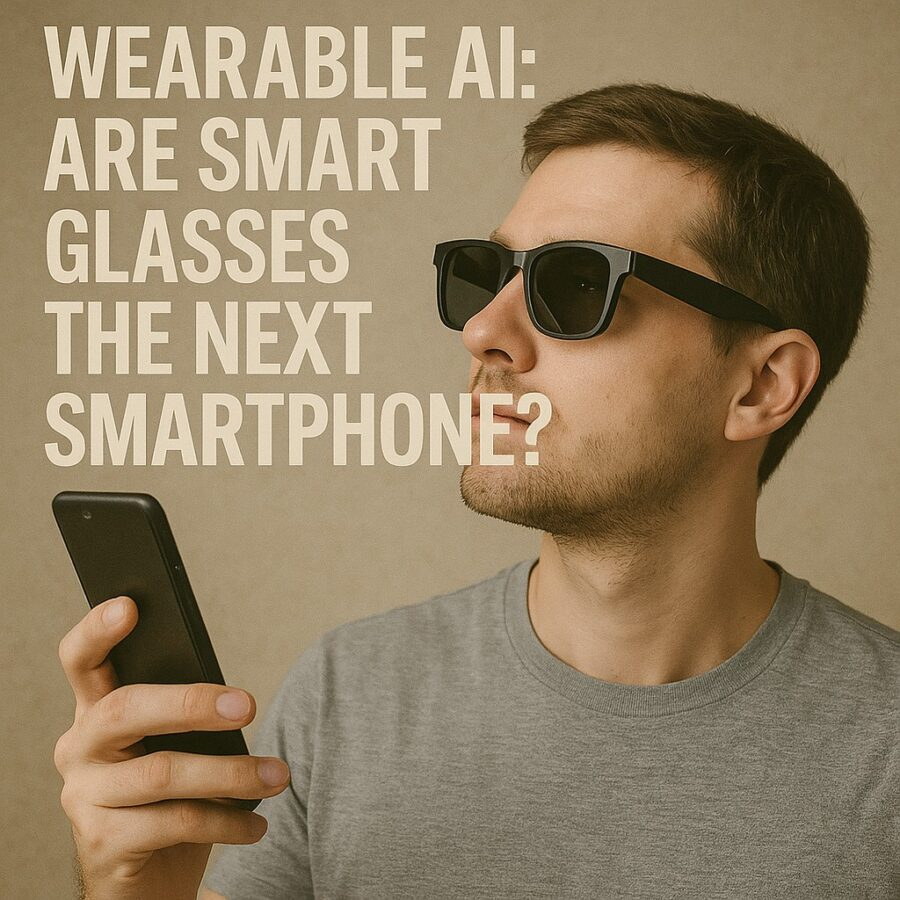The smartphone revolution defined the early twenty-first century. It reshaped communication, commerce, entertainment, and even human attention. Yet every revolution eventually matures, raising the question of what comes next. Increasingly, attention has turned to wearable technology powered by artificial intelligence. The central debate asks: wearable AI: are smart glasses the next smartphone, or will they fade like past experiments in futuristic eyewear?
This article examines the promise, the challenges, and the cultural implications of wearable artificial intelligence, with smart glasses at the center of speculation.
Why Smart Glasses Matter
Smart glasses represent the fusion of two powerful trends. On one side is wearable computing, which embeds digital systems into daily life. On the other side is artificial intelligence, which processes context, data, and user intent in real time.
Together, these technologies promise seamless interaction with information without the friction of pulling out a phone. Navigation directions could appear in your field of vision. A conversation in another language could be translated instantly. Facial recognition could supply names during networking events.
This is why so many ask the question: wearable AI: are smart glasses the next smartphone? They offer not just convenience but a radical rethinking of how humans engage with technology.

The Smartphone Parallel
Comparisons to smartphones are natural. When the iPhone debuted in 2007, many underestimated its significance. Over time, it became a cultural anchor, integrating communications, entertainment, and commerce.
Smart glasses may follow a similar trajectory. Early iterations may appear niche or gimmicky. Yet as functionality expands, the potential for widespread adoption grows. The debate around wearable AI: are smart glasses the next smartphone mirrors the skepticism and excitement once directed at mobile devices.
Early Attempts and Lessons Learned
Google Glass launched in 2013 with bold promises but faltered. Critics cited privacy concerns, limited applications, and awkward design. Snap Spectacles found some success among younger audiences but remained limited in scope.
These early failures offer valuable lessons. For smart glasses to succeed, they must balance style with utility, and AI must provide meaningful advantages over existing devices.
The question of wearable AI: are smart glasses the next smartphone cannot be answered by past failures alone. Instead, it must be asked in light of current technological progress.
Advances Enabling the Next Generation
Several breakthroughs now make smart glasses more viable:
- Miniaturized hardware: Processors and batteries have become smaller and more efficient.
- AI assistants: Large language models allow natural interaction without cumbersome menus.
- Augmented reality overlays: Improved displays can project information that feels integrated into the environment.
- Connectivity: 5G and future networks enable faster data exchange for real-time processing.
These advances suggest that the era of wearable AI: are smart glasses the next smartphone may be approaching more quickly than skeptics expect.
Potential Use Cases
The promise of smart glasses lies in their versatility.
- Navigation: Directions displayed in a driver’s or pedestrian’s line of sight.
- Healthcare: Surgeons accessing patient data without glancing at screens.
- Education: Students seeing interactive lessons projected in classrooms.
- Workplace productivity: Technicians viewing repair instructions while keeping hands free.
- Social interaction: Real-time translation bridging language barriers.
These scenarios show why many argue wearable AI: are smart glasses the next smartphone. The use cases extend beyond convenience into efficiency, safety, and access.
](https://altpenguin.com/wp-content/uploads/2025/08/veed-ad.webp)
The Cultural Barrier
Technology does not succeed on functionality alone. Culture determines adoption. Early smartphone critics dismissed constant connectivity as unnecessary. Yet cultural norms shifted, and carrying a mobile device became universal.
Smart glasses face a similar hurdle. Concerns about surveillance, distraction, and social awkwardness loom large. Glasses are more visible than phones, and people may resist wearing technology on their faces.
This cultural skepticism shapes the ongoing debate: wearable AI: are smart glasses the next smartphone or simply too intrusive for mainstream acceptance?
Privacy and Ethical Concerns
Smart glasses raise unique ethical issues. Cameras embedded in everyday eyewear spark fears of constant recording. AI-driven facial recognition may track individuals without consent. Even with safeguards, the perception of surveillance could hinder adoption.
Regulation may intervene. Laws could restrict facial recognition or mandate visible indicators when recording occurs. Companies will need to build trust through transparency and design choices.
Without addressing these concerns, the promise of wearable AI: are smart glasses the next smartphone will remain limited by fear rather than potential.
Competition in the Market
Technology giants are racing to capture the opportunity.
- Apple is rumored to be exploring wearable devices that integrate seamlessly with its ecosystem.
- Meta has invested heavily in augmented and virtual reality, positioning smart glasses as part of its metaverse strategy.
- Google has quietly continued research despite its early missteps.
- Smaller startups focus on niche markets, from industrial applications to language translation.
This competition underscores why wearable AI: are smart glasses the next smartphone is more than speculation. It is a commercial battle with billions of dollars at stake.
The Role of Artificial Intelligence
Artificial intelligence is the differentiator between past failures and future success. Without AI, smart glasses are simply head-mounted displays. With AI, they become context-aware assistants.
Imagine glasses recognizing a landmark and narrating its history, or analyzing a spreadsheet in your view and suggesting insights. AI transforms raw data into meaningful experience.
This is why the phrase wearable AI: are smart glasses the next smartphone centers not on hardware alone but on the intelligence that drives the experience.
Generational Shifts in Adoption
Younger generations may embrace smart glasses more readily. Just as millennials grew up with smartphones as a natural extension of identity, Gen Z and Gen Alpha may see wearable AI as ordinary. Schools, workplaces, and entertainment ecosystems could normalize adoption.
Generational acceptance may prove decisive in answering wearable AI: are smart glasses the next smartphone. Technology often succeeds when younger users adopt first, creating momentum for broader society.
Economic Implications
If smart glasses achieve mass adoption, economic consequences will follow. Advertising could move from screens to augmented overlays. Retailers could use location-based promotions displayed in real time. Entire industries of app developers, accessory makers, and content creators would emerge.
As with smartphones, the economic ripple would extend far beyond the devices themselves. The debate over wearable AI: are smart glasses the next smartphone is not just cultural but financial, with trillions of dollars in potential impact.
Risks of Overhype
Caution remains necessary. The technology industry often oversells potential. Virtual reality was predicted to replace traditional media years ago but remains niche. Smart glasses could face similar delays if practicality does not match excitement.
Overhyping leads to consumer disappointment and investor fatigue. To avoid this cycle, developers must deliver genuine value early. Otherwise, the vision of wearable AI: are smart glasses the next smartphone could falter before it begins.

The Path Forward
Several factors will determine the outcome:
- Design: Glasses must be stylish, lightweight, and comfortable.
- Battery life: Devices need all-day performance to rival smartphones.
- Privacy: Transparent policies and visible cues for recording are essential.
- AI integration: The intelligence must feel natural, not forced.
- Affordability: Mass adoption requires reasonable pricing.
If these conditions are met, the answer to wearable AI: are smart glasses the next smartphone could be yes. Without them, adoption will remain limited to niche markets.
Closing Thoughts
Every era of technology has its defining device. The personal computer, the smartphone, and perhaps next, smart glasses. The question wearable AI: are smart glasses the next smartphone encapsulates both hope and doubt.
The future will not be decided by hardware alone. It will depend on design, ethics, economics, and culture. If these align, wearable AI could redefine daily life as profoundly as the smartphone once did.
Until then, the debate remains open. What is certain is that the pursuit of wearable intelligence is not slowing. Whether smart glasses become the next universal tool or a stepping stone toward something else, they will shape the trajectory of technology in the years ahead.
Views: 3


